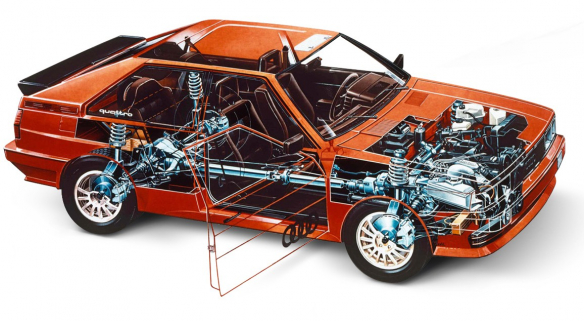Bevel gear center differential
The first Audi quattro, which debuted in spring 1980, was a technical sensation. Its permanent all-wheel drive was lightweight, compact and fast-running, thus making it suitable for high speeds. The elegant quattro principle did not need the heavy, separate transfer case and weighty auxiliary shaft to the front axle that were the standard at the time. It was the first volume-built permanent all-wheel drive system suitable for fast and sporty cars.
The stroke of genius in Audi’s quattro principle, which was developed under the direction of the then Member of the Board for Technical Development Dr. Ferdinand Piëch, was a 263-millimeter (10.35-in) hollowed out shaft in the transmission through which power flowed in two directions. At the rear end, the hollow shaft drove the housing of the slim center differential, which was flanged directly to the shaft. Designed with a classic bevel gear layout, it sent 50 percent of the torque to the rear axle via the prop shaft in every driving situation. The other half of the power was transferred to the front axle’s differential along an output shaft rotating inside the hollow shaft.
The bevel gear center differential eliminated the stresses in the drivetrain that arise because the front wheels follow a slightly larger curve than the rear wheels when the vehicle is cornering. The differential allows them to rotate faster. This proved to be somewhat of a handicap on slippery surfaces. The amount of power that could be transferred was limited by the axle with the lesser traction.
To remedy this, the driver of the Audi quattro could manually lock both the center and the rear axle differential. Initially this was done via two Bowden cable levers between the front seats, but Audi switched to pneumatic activation via switches on the dashboard in 1981. The anti-lock brake system (ABS), which was used in production cars starting in 1983, could not be activated during locking phases due to the rigid drive shaft, however.
Status: 2011
